The problem skulls from Yunxian
The relationships of fossils from deep time in China may help reveal ancestral connections for the Denisovans
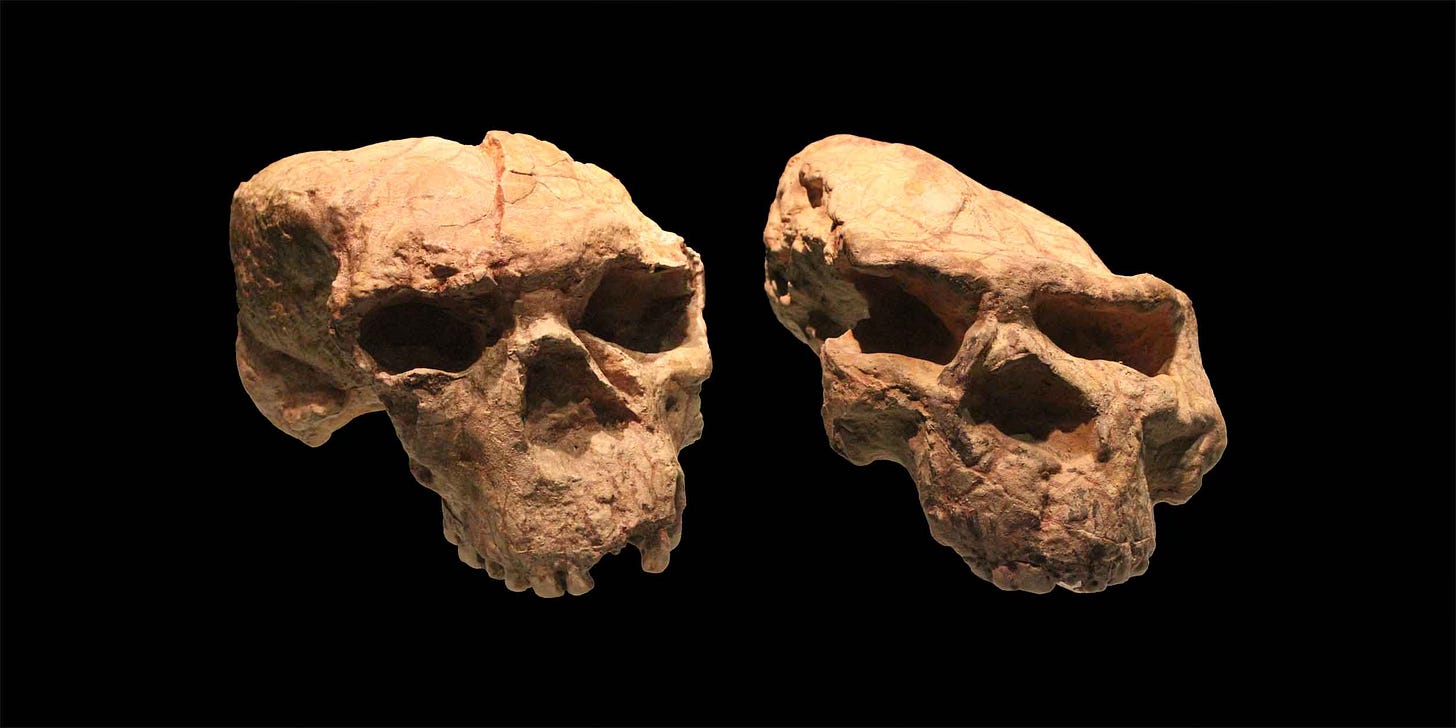
One of the most exciting fossil hominin sites in China is the Xuetangliangzi site, in Hubei province, often known as the Yunxian hominin site. Two fossil skulls were discovered there in 1990. Based on their long, low shape, thick browridges, and thick cranial bone, most anthropologists accepted the skulls as examples of Homo erectus. The most current geochronological estimates brackets these skulls and associated tools and animal remains to the period between 1.1 million and 600,000 years ago.
New research at the site picked up in 2021 with the opening of new excavation areas. In 2022 archaeologists discovered a third skull. This third skull is said to be better preserved than the previous two, which both were highly distorted by their burial environment. But so far, the new skull’s appearance is a close secret held by the researchers involved in studying it.
This week in Science, Xiaobo Feng and collaborators report their new research on one of the two 1990 skulls, Yunxian 2. The new research is not about the new skull. Instead, using virtual anthropology methods, they reconstructed the previously-known Yunxian 2 skull and compared it with other hominins. According to their analysis, this skull should be recognized as part of the same hominin lineage as the later Middle Pleistocene skull from Harbin, China, designated as Homo longi at the time of its description in 2021.
I like whenever Science publishes provocative studies like this. They can help the field think through some of the most challenging problems.
Yet there’s a reason I’m using the words provocative and challenging. The headlines I’ve seen about this study today are all just nonsense. It doesn’t “rewrite human evolution”, “point to earlier origin of modern humans”, or “redraw the human family tree.”
What this research should have done is to put the anatomical comparisons into context with the previous results from DNA, especially the genomes that enable us to understand the relationships of Denisovan, Neanderthal, and modern human groups. This study did not do that.
I’m going to give that a bit of a try. What I think is that the new work helps to show the overlap of variation of the Denisovan group with Homo erectus and other archaic groups of humans in skull size, shape, and form. That overlap reflects both adaptation and possibly some gene flow—and may help us to understand the superarchaic signature of DNA mixture in ancient people.
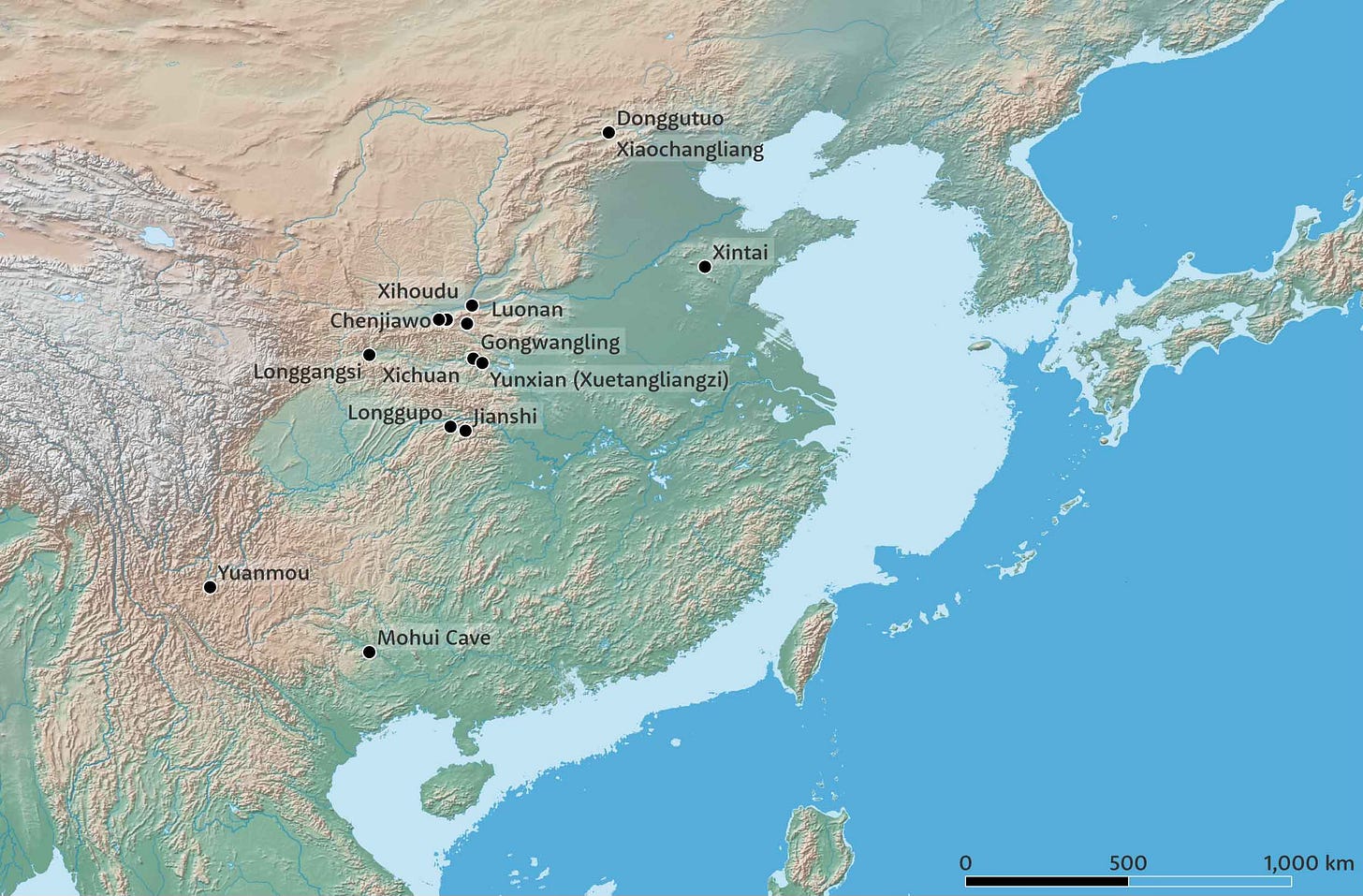
The Xuetangliangzi site
The site commonly known as the Yunxian hominin site, more specifically as Xuetangliangzi, is in Hubei province of central China, around 500 km northwest of the city of Wuhan. The site is on the north bank of the Han River, which flows ultimately into the Yangtze.
Xuetangliangzi has fossils and archaeological remains because they were preserved within ancient terraces of the Han River. Terrace deposits form when rivers deposit sediments over their banks, and later shifting of the river course cuts down further, leaving the terraces above the river bed and floodplain. Erosion of gullies, small tributary streams, and sheet erosion from rainfall can expose the fossils and artifacts and reveal them to archaeologists. Terrace deposits can sometimes yield highly detailed evidence of ancient landscapes where hominins and other animals interacted.
The work at the Xuetangliangzi site in the late 1980s and early 1990s led to the discovery of the Yunxian 1 and 2 skulls, together with a range of stone tool evidence and fossil animal bones. These skulls were unearthed from the T4 terrace deposit, which is constrained to a maximum age of around 1.1 million years. Electron spin resonance dating of mammal remains from the T4 terrace was carried out in the 1990s and yielded dates in the range of 580,000 years. A recent review of work at the site by Jiaqun Hua and collaborators concluded that the ESR ages might be considered a minimum, so the fossils might be between 1.1 million and around 600,000 years old.
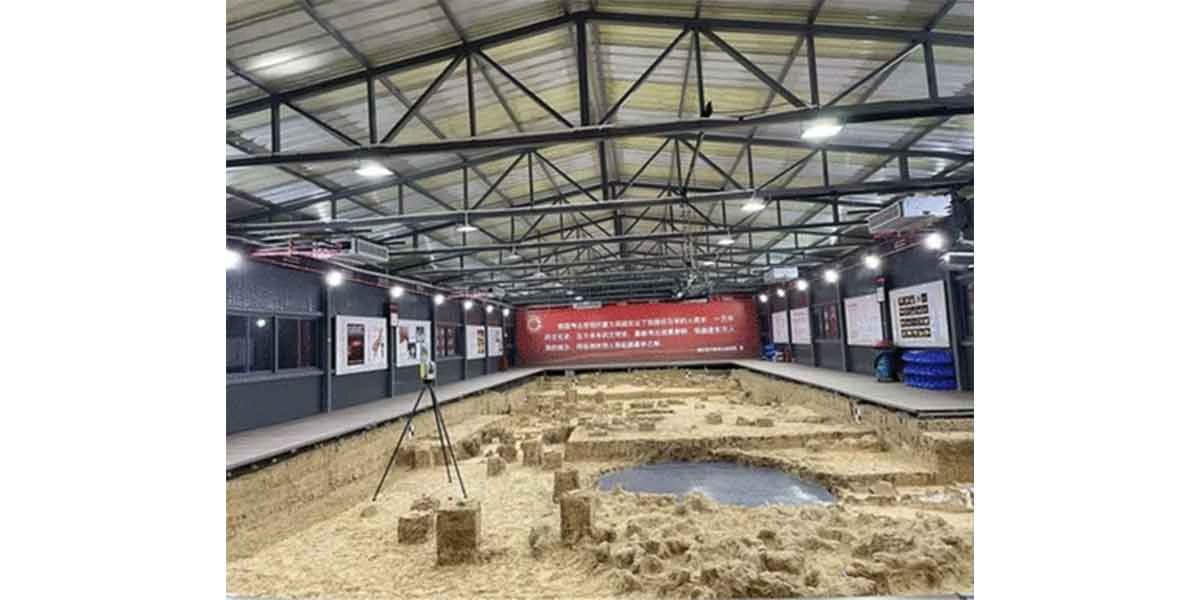
The site itself has undergone some major preservation work with the construction of protective roofs for some of the excavation areas. These are illustrated in a recent paper by Wenyuan Niu and collaborators, who provide some additional information about excavation and recording protocols of the work that began in 2021.
The sandy, fine-grained sediment structure has preserved many of the fossils very well, including the hominin skulls. However, the weight of overlying sediment and lack of mineralization left the remains susceptible to post-burial deformation. Nevertheless, the preservation of bones of the face and cranial base—no matter how distorted—makes them two of the most complete skulls known from the Early Pleistocene of Eurasia.
It is not known why three hominin skulls are here. The first two were excavated around 3 meters from each other, and whether they represent individuals that died around the same time or a spatial coincidence is not clear from what has been published. Equally unclear to me is whether the preservation of fossils more generally would enable the identification of other hominin elements if they were present.
The discovery of the third skull is a big deal. I’m looking forward to learning more about its context and the broader scope of hominin activities that might be evidenced by this site
DNA and the Denisovans
Today when people want to find their relatives, they can have their DNA sampled and compared with datasets of other people who are looking for relatives. More and more, geneticists can do the same thing with DNA from ancient skeletons.
Earlier this year, Qiaomei Fu and her laboratory showed convincingly that the Harbin skull has a mitochondrial sequence that falls within the variation of a series of hominin remains from Denisova Cave, popularly known as “Denisovans”. The Harbin skull also produced proteomic evidence more like the high-coverage Denisova 3 genome than Neanderthal or modern human genomes.
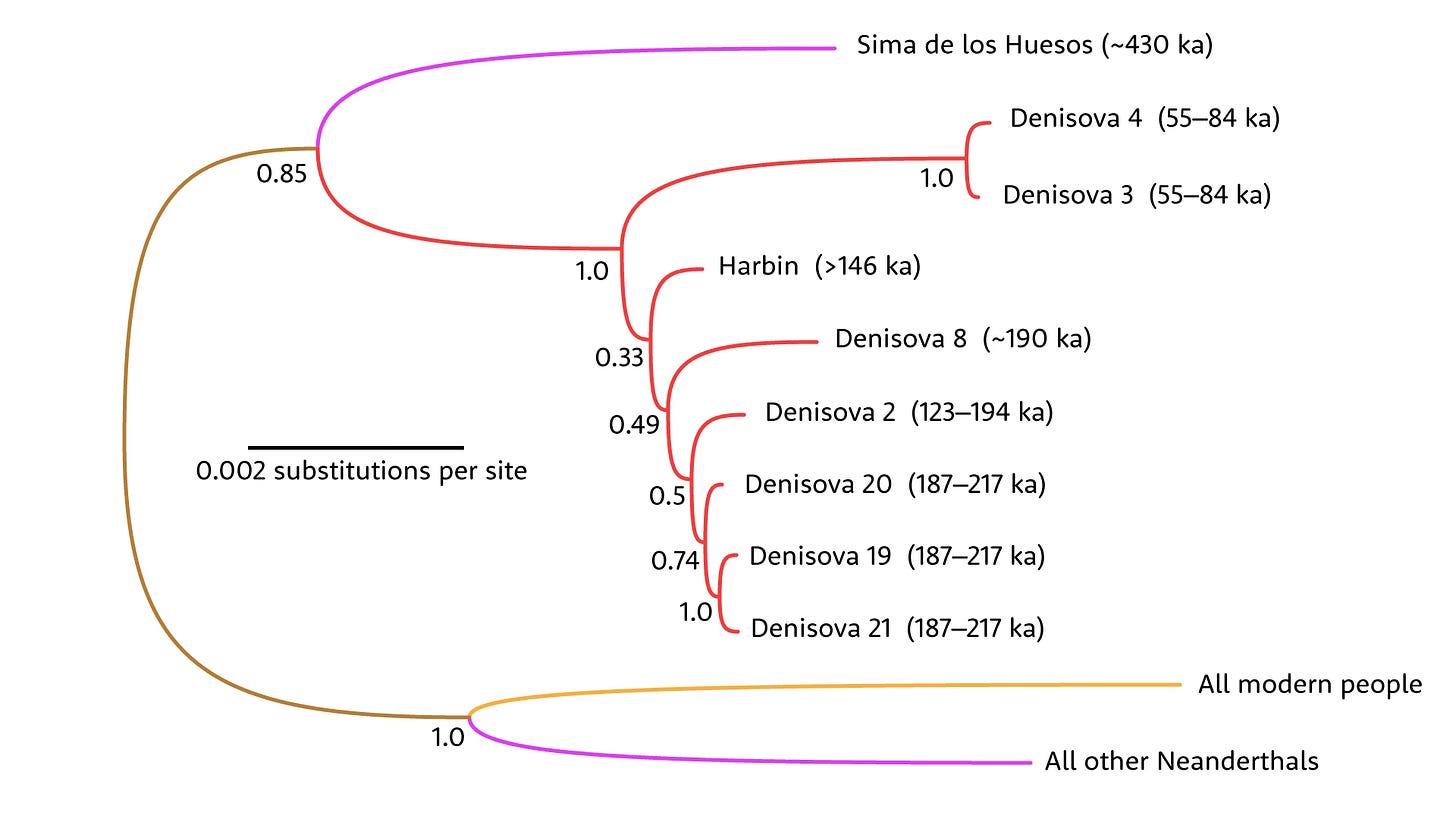
Those results suggest that the Denisovans and Harbin skull should be classified together. One way of handling this would be to keep using the term “Denisovan” and include Harbin in the group. Another way would be to use the species name Homo longi, with the Harbin skull as its holotype, for the entire group. I think all these groups, including Neanderthals, should be recognized within our own species, Homo sapiens. I have no objection to using either “Denisovans” or “Longren” (Dragon people) for these populations with Denisova-like DNA.
Geneticists have learned quite a bit about the evolutionary history of Denisovans from the Denisova 3 genome. This group came from common ancestors with Neanderthals that lived before 600,000 years ago, and those common ancestors—which Alan Rogers and coworkers called “Neandersovans”—separated from the African groups that gave rise to modern humans around 750,000 years ago.
Those estimates for population divergence have ranges of uncertainty. Our lack of exact knowledge of mutation rates over time contributes to this uncertainty, as does the intrinsic variation in genealogies of genes within ancient populations, and our lack of exact knowledge of the ages of the ancient DNA sequences themselves.
How Yunxian 2 does (or does not) fit in
The reconstruction that Feng and collaborators present of Yunxian 2 shares most of its features with the series of reconstructions started twenty years ago by Amélie Vialet and collaborators. I have a good cast of that reconstruction in my lab, so I could compare it to the new work.
The new reconstruction raises the top of the skull, correcting the flattening of the parietals, and results in slightly less angulation at the back of the skull. Overall, these corrections of the distortion of the parietal bones have the effect of making the skull a bit higher and rounder than the previous reconstruction. That shape results in a somewhat larger estimate of endocranial volume, up to an estimated 1143 ml, which is quite large for Homo erectus.
It’s those changes that make the skull seem a little more like the Harbin skull, and a little less like other skulls attributed to Homo erectus, such as the roughly 800,000-year-old Sangiran 17 skull from Indonesia.
Are these alterations enough to classify this skull together with the Harbin or Dali fossils? I wouldn’t go so far.
Bigger and rounder may not have much special evolutionary importance, when many of the samples attributed to Homo erectus or archaic humans overlap with each other in size and shape. To understand the classification and relationships of these fossils, we instead need to look closely at the areas of overlap and observe whether there are traits that differentiate skulls that are similar in size and gross shape.
That’s hard to do with samples that only number one or two individuals, of course. The limitations of the fossil record always make classification a challenge.
But there’s one thing that always makes classification harder: Not being able to see all the fossils. I like this study in many ways, but one thing that really irritates me is that it has been published without including the most valuable evidence: the new skull discovered three years ago from the same site, reportedly less distorted than Yunxian 1 and 2.
Of course, I understand that the preparation, study, and analysis of a fossil skull may take a long time. And the review process has become positively glacial. This new paper by Feng and coworkers was in review and revision since the preprint was released in February 2024. I sympathize that scientists who are working on other aspects of a site or fossil sample cannot hold their results indefinitely waiting for all the evidence to emerge. They have to move forward with what they have.
Still, in this case it seems pretty obvious that Yunxian 3 is going to be central to testing the relationships of this sample. Not being able to see that key fossil means that none of us can evaluate the evidence fully.
So the phylogenetic tree in the paper is based only on partial comparisons with the sample of skulls from Yunxian. The outcome shows “Yunxian” to be grouped together with the Dali skull, the Harbin skull, and other East and Central Asian fossils, as well as with the Homo antecessor fossil material from Gran Dolina, Spain. The authors interpret this group as the Homo longi lineage, and estimate that it diverged from our own species around 1.3 million years ago.
A small point is that this divergence at 1.3 million years is a result from “Bayesian tip dating” of the entire group of fossils. This result is not very strongly influenced by the estimated age of the Yunxian 2 skull itself. The skull could be a lot younger and still be within a group with an ancient 1.3 million-year divergence time. I’m noting that because the Yunxian association with ESR dates potentially as recent as 600,000 years or less does leave open the possibility that these individuals were in the time range of Denisovans.
It’s the overall analysis in the paper that poses the problem, not the particular age of the Yunxian skulls. The phylogenetic results simply do not match what DNA evidence has established about the ancestry of Neanderthals, Denisovans, and modern people. The tree shown by Feng and coworkers places Homo longi and modern humans as sister groups, with Neanderthals as an outgroup. The separate branching of Neanderthals, close to 1.4 million years ago, is almost double the timeline that comes from comparisons of whole genomes from these groups.
Is there a way to square this study with DNA?
I wrote a little bit about this study as a preprint earlier this year. The preprint was posted in early 2024 before any public notice of the Harbin mtDNA and proteomic results were known. Even without the DNA confirmation that Harbin belongs to the Denisovan group, the analysis seemed to contradict what DNA has been telling us for the last decade about archaic humans.
On the surface, this new work seems to face scientists like me with a stark choice. Do we accept the DNA results that show that the Harbin skull belongs to a lineage that first separated from African ancestors of today’s people around 700,000 years ago? Or do we accept that the skull belongs to a lineage with the Yunxian 2 skull that extends back 1.3 million years or more?
In my earlier post on the Harbin DNA and proteomic results, I suggested a third way. Maybe the deep ancestry of Denisovans included earlier Homo erectus-like populations of East Asia.
Alan Rogers and collaborators in 2020 showed that the common ancestors of Neanderthals and Denisovans derived some of their ancestry from another deep lineage. They estimated that this “superarchaic” lineage had diverged from other African populations more than 2 million years ago.
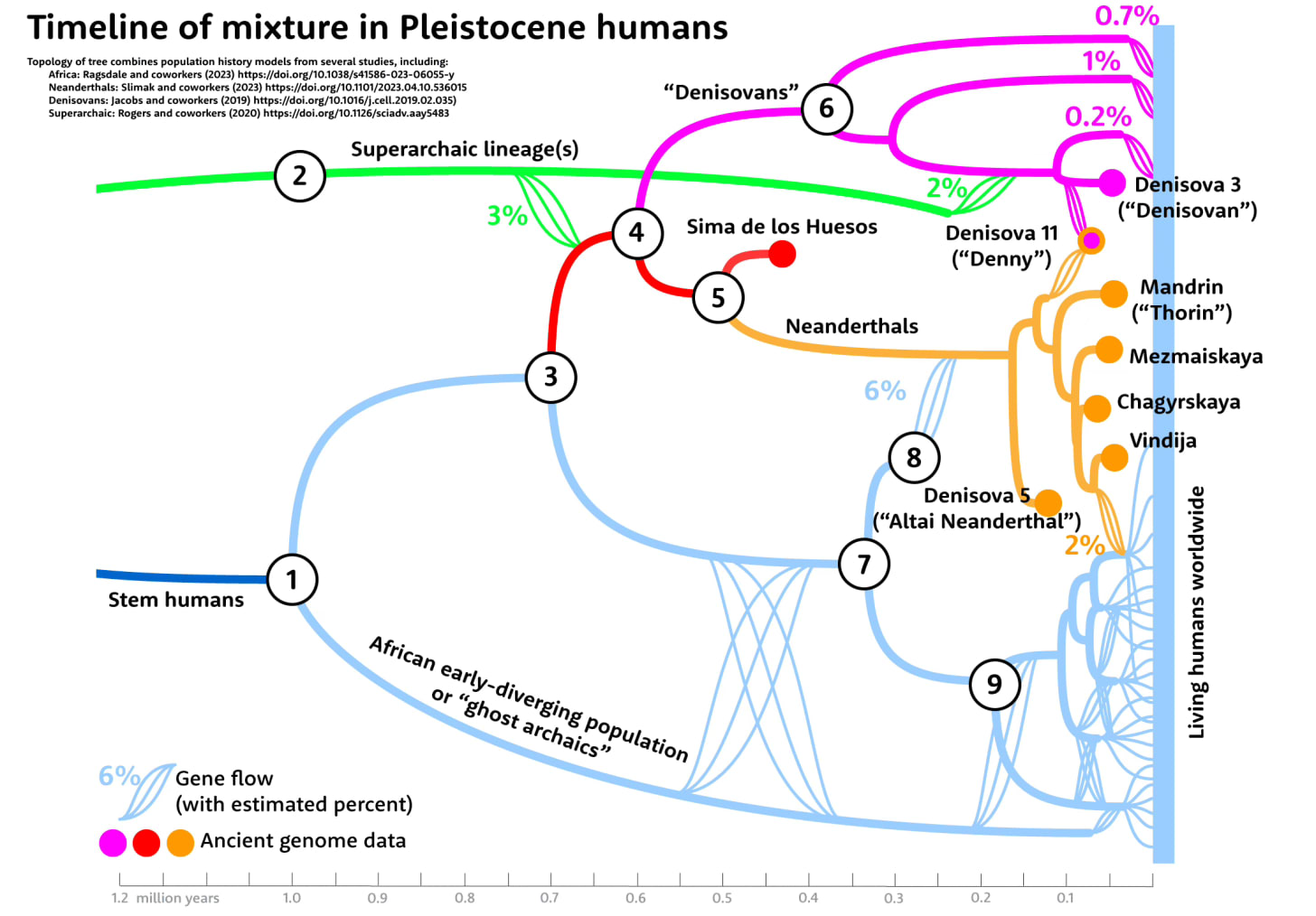
Who were those superarchaic people? An obvious possibility is one or more of the groups scientists usually call Homo erectus. The timeline of initial origin and movement of H. erectus into Eurasia as represented at Dmanisi, Republic of Georgia, could mean that the first dispersal from Africa was still echoing down through genetic mixture into both Denisovans and Neanderthals.
Rogers and collaborators could not rule out some other possibilities. It’s always hard to tell whether a single small contribution of DNA came from one unknown population, or from two or more. Maybe a more complex history had happened, with multiple dispersals from Africa, some very early, some a bit later. What was clear was that including some ghost ancestry helped explain discrepancies in the pattern of DNA similarities that just didn’t seem to work otherwise.
From my point of view, there is no reason why DNA and morphology have to be interpreted as conflicting with each other. Both sets of information reflect the same history. The DNA can give a much more finely resolved genealogical picture than measuring skulls. At the same time, the skulls reflect some aspects of adaptation and ecological relationships that are hard to see from DNA alone.
For me, this is the real conclusion of the new study. The ancient groups of China and East Asia were loosely connected with each other in a network that spanned potentially hundreds of thousands of years. Newcomers who arrived in the region, such as the first Denisovans, would have encountered people whose ancestors had been adapting to local situations for a very long time.
Their biology overlapped. Some of that overlap was a legacy of the incomplete lineage sorting of their ancestral groups. Some reflected genetic exchanges. Some of the overlap was the outcome of natural selection within the ecologies they shared.
This pattern of evolution doesn’t make it easy for scientists to classify any of these ancient people. The overlap may have been greatest in exactly the parts of their biology that were most important to their survival and success. Naming these groups as different species is probably not the right way to classify them.
That doesn’t mean that some big differences did not sometimes evolve—We know they did! But it does suggest that the differences were the kind that evolve among the populations of a single species over time, not starkly different groups that tread the landscape in mutually unrecognizable ways.
Notes: Another name used in scholarly sources for the Xuetangliangzi site is Quyuanhekou, this name refers to the tributary river Quyuan that joins the Han river near the site.
The government of Wuhan has a public post about the discovery of the third Xuetangliangzi (Yunxian) skull back in 2022. The post includes the best photos I’ve seen of the cranium, which were taken during the process of excavation. They don’t give much away!
References
Feng, X., Lu, D., Gao, F., Fang, Q., Feng, Y., Huang, X., Tan, C., Zhou, H., Li, Q., Zhang, C., Stringer, C., & Ni, X. (2024). The phylogenetic position of the Yunxian cranium elucidates the origin of Dragon Man and the Denisovans (p. 2024.05.16.594603). bioRxiv. https://doi.org/10.1101/2024.05.16.594603
Fu, Q., Bai, F., Rao, H., Chen, S., Ji, Y., Liu, A., Bennett, E. A., Liu, F., & Ji, Q. (2025a). The proteome of the late Middle Pleistocene Harbin individual. Science, 0(0), eadu9677. https://doi.org/10.1126/science.adu9677
Fu, Q., Cao, P., Dai, Q., Bennett, E. A., Feng, X., Yang, M. A., Ping, W., Pääbo, S., & Ji, Q. (2025b). Denisovan mitochondrial DNA from dental calculus of the >146,000-year-old Harbin cranium. Cell, 0(0). https://doi.org/10.1016/j.cell.2025.05.040
Han, F., Bahain, J.-J., Shao, Q., Sun, X., Voinchet, P., Xiao, P., Huang, M., Li, M., & Yin, G. (2022). The Chronology of Early Human Settlement in Three Gorges Region, China—Contribution of Coupled Electron Spin Resonance and Uranium-Series Dating Method. Frontiers in Earth Science, 10. https://doi.org/10.3389/feart.2022.939766
Hua, J., Ge, J., Lu, C., Shen, Z., Xing, S., Lu, Z., Gao, X., & Deng, C. (2025). Chronological studies of the Xuetangliangzi hominin fossil site in Hubei Province. Acta Anthropologica Sinica, 44(02), 316. https://doi.org/10.16359/j.1000-3193/AAS.2025.0015
Niu, W., Lu, C., Zou, Q., Luo, Y., Wang, X., Xiang, H., Zhang, F., Gao, X., Xing, S., Wei, X., Lou, W., Huang, D., Wang, C., Jiang, D., Wan, X., Zhang, Z., Yin, H., Lu, J., Wang, F., … Li, Y. (2024). Dynamically documenting archaeological excavations based on 3D modeling: A case study of the excavation of the #3 fossil of hominin cranium from Yunxian, Hubei, China. Heritage Science, 12(1), 279. https://doi.org/10.1186/s40494-024-01356-5
Rogers, A. R., Harris, N. S., & Achenbach, A. A. (2020). Neanderthal-Denisovan ancestors interbred with a distantly related hominin. Science Advances, 6(8), eaay5483. https://doi.org/10.1126/sciadv.aay5483
Tianyuan, L., & Etler, D. A. (1992). New Middle Pleistocene hominid crania from Yunxian in China. Nature, 357(6377), 404–407. https://doi.org/10.1038/357404a0
Vialet, A., Li, T., Grimaud-Hervé, D., de Lumley, M.-A., Liao, M., & Feng, X. (2005). Proposition de reconstitution du deuxième crâne d’Homo erectus de Yunxian (Chine). Comptes Rendus Palevol, 4(3), 265–274. https://doi.org/10.1016/j.crpv.2004.12.004
Vialet, A., Guipert, G., Jianing, H., Xiaobo, F., Zune, L., Youping, W., Tianyuan, L., de Lumley, M.-A., & de Lumley, H. (2010). Homo erectus from the Yunxian and Nankin Chinese sites: Anthropological insights using 3D virtual imaging techniques. Comptes Rendus Palevol, 9(6), 331–339. https://doi.org/10.1016/j.crpv.2010.07.017


Should we discuss the elephant in the room? There's a thread of research influenced by Chinese nationalism that champions the thought of either the origins of sapiens in Asia or, at the very least, the evolutionary origins of the Chinese in Asia rather than Africa. I've seen Chinese geneticists argue that the genetic evidence is opposite of the out of Africa theory. I'm really starting to wonder if this discrepancy between genetic evidence and the morphological analyses coming out of the region is biased for this reason. Or is it really just a matter of morphology and DNA not behaving in a lockstep manner?
Having seen some "over the top" headlines in the popular press, I was waiting for your sober, cautious opinion. Thanks for keeping us on track.